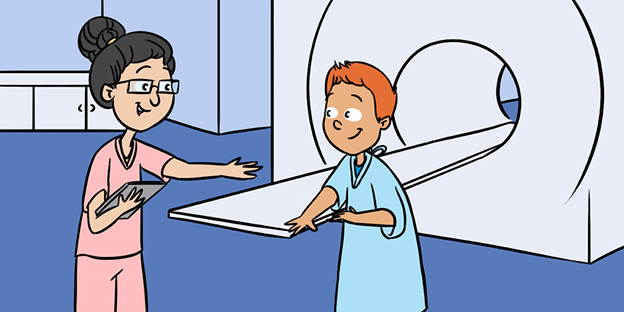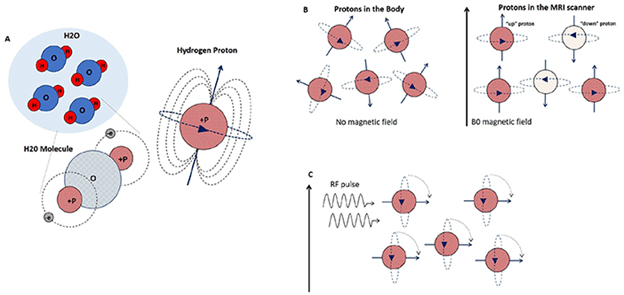ام آر آی
ام آر آی – تصویربرداری رزونانس مغناطیسی
اگر شما تا کنون برای تصویربرداری از بدن خود پا به مراکز تشخیصی درمانی هم نگذاشته باشید باز هم نام ام آر آی و اسکن MRI را شنیده اید. ام آر آی دیگر یک تکنیک نیست بلکه یک اصطلاح و مفهومی از تشخیص پزشکی در ذهن عامه مردم است. پس اگر تا کنون تنها از این روش تصویربرداری یک نام در ذهن شما نقش بسته و قصد دارید تا اطلاعات خود را در مورد فیزیک و نحوه کارکرد دستگاه MRI به زبان ساده ارتقا بخشید، پیشنهاد می کنیم تا این مقاله را از دست ندهید.
اگر به طور خیلی ساده قصد داشته باشیم کلیات ام آر آی ( MRI ) را تعریف کنیم می توانیم بگوییم، تصویربرداری با رزونانس مغناطیسی یا همان ام آر آی MRI به ما امکان می دهد تا با استفاده از آهن ربا و امواج رادیویی، بدن انسان را با جزئیات شگفت انگیز مشاهده نماییم. اولین اسکنر MRI که برای تصویربرداری از بدن انسان استفاده شده است در سال 1977 در نیویورک ساخته شد. از آن زمان، این فناوری بسیار ارتقا یافته و اکنون ام آر آی ( MRI ) توسط تمامی پزشکان در دنیا به عنوان یک تصویربرداری استاندارد و قابل اطمینان به طور مکرر مورد استفاده قرار می گیرد. شاید یکی از مزیت های کلیدی تصویربرداری MRI این است که MRI شامل تابش اشعه های پرخطر (مانند اشعه ایکس یا سی تی اسکن) نیست و هیچ گونه اثر تهاجمی بر روی بدن ندارد.
اسکنر MRI در اصل یک آهنربای غول پیکر است. قدرت آهنربا در واحد استانداردی به نام تسلا (T) اندازه گیری می شود. بیشتر اسکنرهای MRI که در بیمارستان ها و کلینیک های تحقیقات پزشکی مورد استفاده قرار می گیرند 1.5 یا 3 تسلا هستند. برای روشن شدن مقیاس بزرگی تسلا بد نیست بدانید که میدان مغناطیسی زمین در حدود 0.00006 تسلا است!!!
سوال اصلی این است که این میدان مغناطیسی فوق العاده قوی به چه دردی می خورد؟ برای پاسخ به این سوال باید بدانید که همه این نیروی مغناطیسی صرف جذب مولکول های آب درون بافت های بدن می شود.
پس باید ببینیم این اتم های هیدروژن چه قابلیتی دارند که تا این حد در تصویربرداری نقش حیاتی ایفا می کنند. اگر با دقت بیشتر اتم هیدروژن را بررسی کنیم، می بینیم که شامل یک هسته مرکزی حاوی یک بار مثبت منفرد به نام پروتون است. این پروتون ها حول محور خود با قطب مغناطیسی شمال و جنوب در حال گردش هستند و هر پروتون هیدروژن در حال چرخش مانند آهنربایی ریز است که در محور خود می چرخد. این حرکت چرخشی به عنوان Precession شناخته می شود. در هر لحظه از زمان، تمام میلیاردها میلیارد پروتون هیدروژن در بدن ما در موقعیت های تصادفی قرار دارند و حول محورهای خود می چرخند.
با این حال، این موقعیت های تصادفی زمانی که در یک میدان مغناطیسی بسیار قوی قرار می گیرند به کلی تغییر می کند. درست مانند زمانی است که یک سوزن قطب نما با میدان مغناطیسی زمین تراز می شود. هنگامی که این پروتون های هیدروژن در حال چرخش به طور تصادفی در یک اسکنر MRI قرار می گیرند، محورهای آنها در جهت میدان مغناطیسی قوی تر آهن ربای MRI مجددا تنظیم می شوند. ما در اینجا میدان مغناطیسی دستگاه MRI را میدان مغناطیسی اصلی اسکنر B0 می نامیم. پروتونهای هیدروژن وقتی وارد یک اسکنر MRI می شوند ، از نظر جابجایی فیزیکی، در بدن حرکت نمی کنند بلکه محورهای آنها فقط در راستای جهت میدان B0 تراز می شوند. برخی به سمت (بالا) چرخش می کنند و بعضی دیگر (پایین) ، در حالی که هنوز در محورهای خود می چرخند. با توجه به قوانین شگفت انگیز فیزیک کوانتومی، که ما در اینجا به آنها نخواهیم پرداخت ، همیشه تعداد پروتونهای به سمت (بالا )کمی بیشتر از (پایین) می باشد. بر اساس قوانین مغناطیس می دانیم که پروتون های سمت (بالا) و (پایین) اثر یکدیگر را خنثی می کنند تا فقط میدان مغناطیسی را از بخش کوچکی از پروتونهای سمت (بالا)اضافی باقی بماند. این همان میدان مغناطیسی کوچکی است که ما می توانیم با استفاده از MRI اندازه گیری کنیم.
میدان B0 نه تنها بر تراز پروتون هیدروژن تأثیر می گذارد ، بلکه بر سرعت چرخش این پروتون ها نیز تأثیر گذار است(به این سرعت چرخش فرکانس شایع گفته می شود). فرکانس شایع به قدرت میدان مغناطیسی بستگی دارد. هرچه میدان مغناطیسی قوی تر باشد ، پروتون ها سریعتر می چرخند. این دو پدیده در مورد تغییر مجدد محور و فرکانس فوق العاده مهم است و هنگام استفاده از MRI سیگنال های این مولکول های هیدروژن با دقت بالایی اندازه گیری می شود.
چگونه میدان مغناطیسی را اندازه گیری می کنیم؟
بنابراین چگونه میدان مغناطیسی ریز ناشی از پروتونهای هیدروژن اضافی (بالا) در بدن خود را از میدان عظیم B0 اسکنر اندازه می گیریم؟ برای این کار از چیزی به نام فرکانس رادیویی (RF) استفاده می شود. پالس فرکانس رادیویی برای تحریک پروتونهای رزونانس به دور از میدان B0 استفاده می شود. این پالس رادیویی با ایجاد یک اختلال و یا تلنگر روی همه پروتونها موجب می شود تا پروتون ها از مدار میدان اصلی B0 اندکی جابجا شوند (شکل C). فرکانس پالس RF باید برابر با فرکانس پروتونهای هیدروژن در حال چرخش باشد ، بنابراین آنها می توانند انرژی را مبادله کنند به این فرکانس در فیزیک که بیشترین تبادل انرژی صورت می پذیرد فرکانس رزونانس یا تشدید می گویند. رزونانس پروتون ها را قادر می سازد تا انرژی کافی از پالس RF را جذب کنند تا محورهای خود را از میدان B0 بچرخاند ، به طوری که اسکنر MRI قادر به اندازه گیری آن باشد. اگر دوباره در مورد قطب نما در میدان مغناطیسی زمین که به سمت قطب شمال می رود فکر کنیم ، اگر یک آهنربای میله ای کوچک در کنار قطب نما قرار دهیم می توانیم سوزن را بچرخانیم تا به سمت شرق بچرخد. این شبیه به روشی است که پروتونها هنگام روشن کردن پالس RF رفتار می کنند.
در کل می توانیم بگوییم بدن پر از پروتونهای هیدروژن سمت (بالا) است که همه در همان فرکانس غالب در B0 می چرخند ، چگونه ما فقط آنهایی را که در مغز هستند هدف قرار می دهیم تا تصویر مغز مجزا داشته باشیم؟ ما از این واقعیت استفاده می کنیم که فرکانس شایع پروتون ها کاملا وابسته به میدان مغناطیسی است. اگر یک میدان مغناطیسی دوم به نام B1 به نقطه خاصی اعمال شود، پروتونهای هیدروژن موجود در آن قسمت مانند سر سریعتر از آن در سینه ، معده و پاها می چرخند. سپس ،با اعمال پالس RF فرکانس غالب پروتونهای هیدروژن در سر می توان یک سیگنال مجزا از ارگان مطلوب بدست آورد. سپس پالس RF فقط با پروتونهای موجود در مغز تشدید خواهد شد. بنابراین ، فقط پروتونهای موجود در مغز انرژی حاصل از پالس RF را جذب می کنند و از میدان B0 دور می شوند. اگر بخواهیم از پاها تصویر بگیریم ، به همین شکل می توانیم پالس RF خود را تنظیم کنیم تا در سایر قسمتهای بدن مانند پاها با تابش پروتون تشدید شوند.
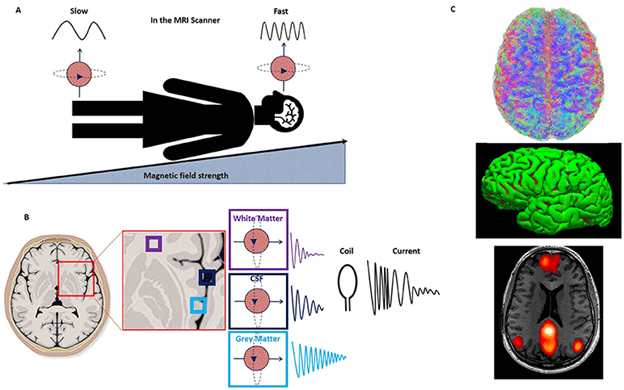
قسمت های مختلف شکل بالا به شرح زیر است.
(A آب از دو اتم هیدروژن و یک اتم اکسیژن تشکیل شده است. هسته هیدروژن (با رنگ قرمز به عنوان P نشان داده شده است) حاوی یک بار مثبت است – یک پروتون که در محور خود می چرخد ، مانند یک آهنربای کوچک عمل می کند.
B) در دستگاه MRI ، پروتونها با میدان مغناطیسی B0 ، مقداری “بالا” (قرمز) و کمی “پایین” (سفید) تراز می شوند. میدان مغناطیسی کل حاصل از تمام پروتونهای هیدروژن تقریباً یکدیگر را لغو می کنند تا فقط میدان مغناطیسی را از قسمت کمی از پروتونهای اضافی (بالا) باقی بماند، و این میدان مغناطیسی کوچکی است که می توانیم با استفاده از MRI اندازه گیری کنیم.
(C هنگامی که یک موج / پالس RF یا همان فرکانس تشدید پروتون تابیده می شود ، پروتون های سمت (بالا) از میدان B0 دور می شوند ، زیرا انرژی RF را جذب می کنند.
سوال اصلی: چگونه از این اتفاقات تصویر بافت بدن بدست می آید؟
تمامی مطالب بیان شده تا کنون قوانین فیزیکی بود که به سادگی بیان شد و تقریبا برای کسی جای ابهام وجود ندارد. حال می خواهیم بدانیم که از این قوانین فیزیک به ظاهر ساده، در تصویربرداری ام آر آی MRI چگونه استفاده می شود. چیزی که می دانیم این است که ما بایستی از پروتون هایی که در حالت تشدید قرار گرفته اند استفاده نماییم. هنگامی که پالس RF خاموش است، پروتونها به سمت میدان مغناطیسی اصلی یعنی B0 باز می گردند و مجدداً تغییر شکل می دهند. اگر دوباره به مثال قطب نما فکر کنیم ، هنگامی که آهنربای میله کوچک خود را از قطب نما دور می کنیم ، سوزن قطب نما از سمت شرق به شمال می چرخد و یک بار دیگر با میدان مغناطیسی زمین همسو می شود. در ام آر آی MRI نیز پالس RF حکم آهنربای میله ای را دارد که پروتون ها را به حالت تشدید در آورده و محور آن ها را از میدان اصلی خارج نموده است. زمانی که پالس RF قطع می شود، این پروتون ها همانند قطب نمای ما به سر جای اصلی خود باز می گردند. این باز گشت پروتون ها، آزادسازی انرژی نیز با خود به همراه دارد. این انرژی ساطع شده، مبنای اصلی تولید تصویر از بافت بدن می شود. یعنی تنها کافی است تا با استفاده از مکانیزم خاصی این انرژی جذب و تصویر سازی انجام شود. نکته جالب در این است که بافتهای مختلف بدن مقادیر متفاوتی از انرژی از دست می دهند. در نتیجه تصویر هر جز از بدن کاملا مجزا نسبت به سایر قسمت هاست. برای اندازه گیری این انرژی ساطع شده ، به تجهیزات خاصی نیاز داریم (به نام کویل) که در اطراف قسمت بدنه ای که تصویربرداری می کنیم قرار داده شده است. درون این کویل ها، سیم پیچ هایی به عنوان آنتن گیرنده عمل می کند و انرژی آزاد شده را به صورت یک جریان الکتریکی بسیار ضعیف تشخیص می دهد. سیگنال های الکتریکی از طریق کامپیوتر با استفاده از یک مجموعه محاسبات پیچیده ریاضی برپایه تبدیلات فوریه به د اده هایی خام به نام Raw Data جهت تصویرسازی تبدیل می شود. در نهایت از آنجایی که پروتون ها در انواع مختلفی از بافت های موجود در بدن مانند ماده خاکستری، بافت چربی، بافت سخت استخوانی و …، همگی مقادیر مختلف انرژی می دهند، نتیجه انرژی تبدیل شده تصویری کاملاً دقیق از بافت درون بدن است.
6 نکته ای که باید قبل از انجام اسکن ام آر ای بدانید!
تصویربرداری رزونانس مغناطیسی، به اختصار MRI، یک تصویربرداری غیرتهاجمی است که تصویری کاملاً دقیق از بافتهای داخل بدن شما تولید می کند. ام آر آی هم بدون درد و هم بی خطر است. از همه مهمتر، این اسکن می تواند به شما اطلاعات ارزشمندی در مورد مشکلات مربوط به هرجایی از نوک پاها تا مغز را به پزشک ارائه دهد. بنابراین، ممکن است پزشک شما برای تشخیص بیماری در سر، قفسه سینه، شکم، لگن، پاها، بازوها یا رگ های خونی به شما MRI تجویز کند. پس پیش از انجام ام ار ای حقایق مربوط به نحوه کار MRI و. نکات اصلی را در این مقاله یاد بگیرید.
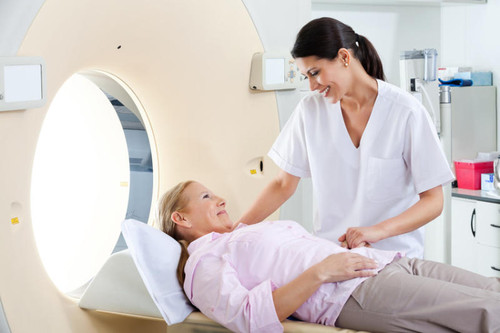
1- در اسکن MRI اشعه ایکس وجود ندارد.
این بدان معناست که هیچ اثر و خطری از اشعه شما را تهدید نمی کند. در عوض، MRI با استفاده از ترکیبی از یک میدان مغناطیسی، امواج رادیویی و رایانه تصاویری خارق العاده از بدن شما ایجاد می کند. همانطور که روی تخت اسکن دراز می کشید، دستگاه MRI امواج رادیویی را از طریق بدن شما ارسال می کند. این باعث تغییرات انرژی می شود. این تجهیزات تغییرات را اندازه گیری کرده و آنها را به تصویر تبدیل می کند. غالباً، MRI تصویر بهتری نسبت به سایر اسکن های رایج مانند اشعه ایکس، سی تی اسکن یا سونوگرافی ایجاد می کند.
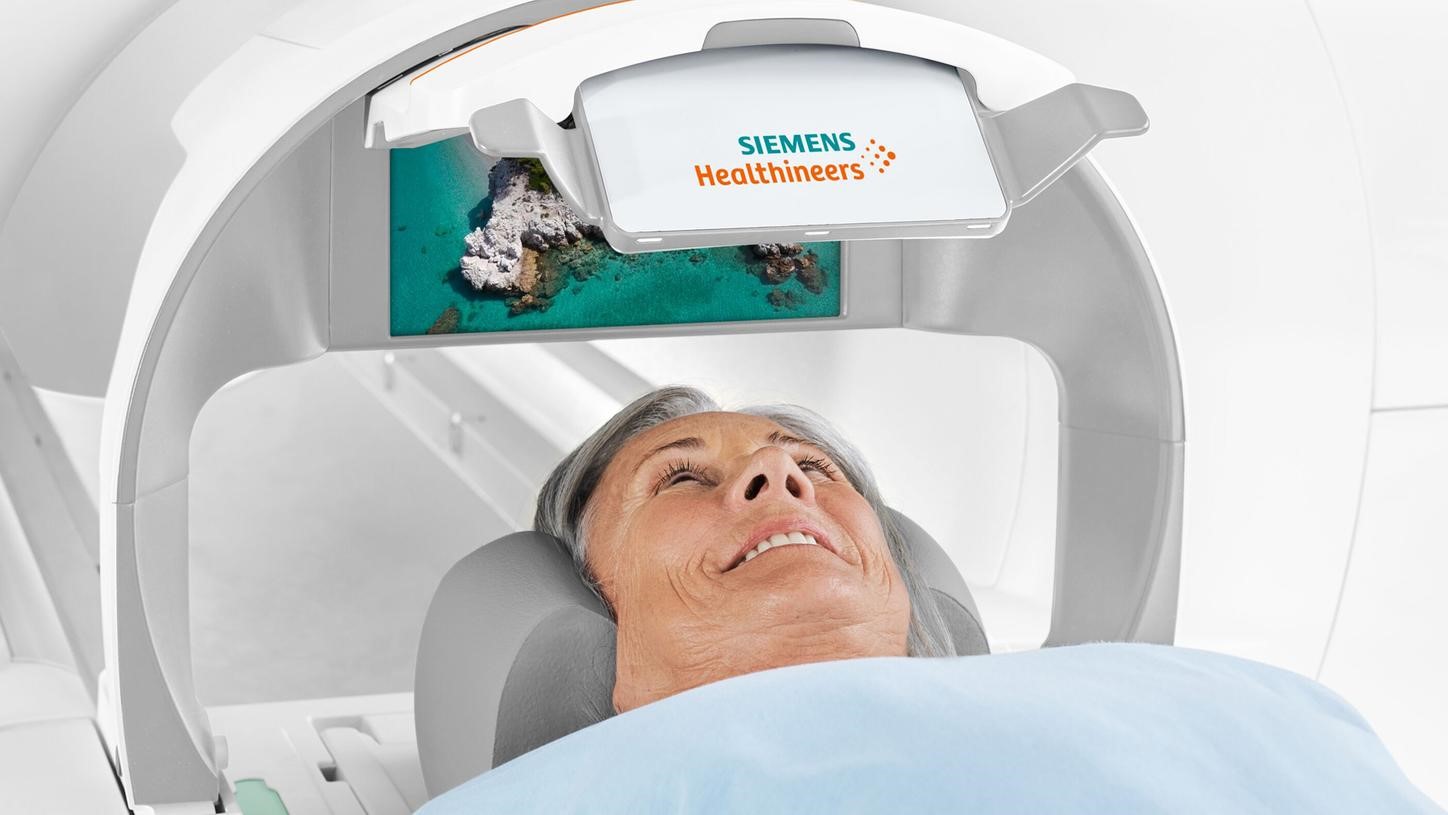
2. فلزهای داخل بدن شما می تواند برای شما دردساز شوند!
از آنجا که MRI از یک آهن ربا های فوق العاده قوی استفاده می کند، می تواند فلزات را در داخل بدن شما حرکت دهد. در صورت داشتن هر نوع کاشت فلز، پروتز و یا پلاتین به پزشک خود اطلاع دهید. پزشک شما همچنین باید ابتدا تشخیص دهد که گلوله یا ترکش فلزی در بدن نداشته باشید. MRI همچنین می تواند به دستگاه های پزشکی فلزی یا الکتریکی مانند ضربان سازهای قلب و یا سمعک آسیب برساند. برخی از دستگاه های پزشکی با MRI سازگار هستند و شما باید یک کارت شناسایی داشته باشید که در آن ذکر شده باشد. قبل از MRI، تکنسین MRI شما تمام اشیا فلزی یا الکتریکی را که ممکن است یک مشکل باشد، از شما تحویل می گیرد. حتماً تمام جواهرات خود را قبل از رفتن به مرکز تصویربرداری در خانه بگذارید.
3- شما ممکن است نیاز به تزریق ماده حاجب در تصویربرداری MRI داشته باشید.
استفاده از ماده حاجب به نام گادولینیوم ممکن است تصاویر MRI را برای برخی شرایط بهبود بخشد. گادولینیوم را از طریق یک تزریق درون وریدی (IV) در بازو یا دست خود دریافت می کنید.حتما از پزشک خود سوال کنید که نوع اسکن شما با تزریق و یا بدون تزریق است. ماد حاجب می تواند در موارد نادر باعث آسیب کلیه شود، بنابراین اگر سابقه بیماری کلیوی دارید حتماً به پزشک خود اطلاع دهید.
4- صدای ام ار ای بسیار زیاد و حتی آزاردهنده است.
ام آر آی بدون درد است، اما قطعاً خیلی پر سر و صداست. یک تخت اسکن متحرک شما را به دستگاه MRI می کشاند. دستگاه چندین عکس می گیرد. زمان هر کدام از تصاویر ممکن است چند دقیقه طول بکشد. در این زمان ها، صدای بلندی مانند ضربه زدن را می شنوید. ممکن است بخواهید از گوشی یا هدفون استفاده کنید. این گوشی ها به شما کمک می کنند تا صداهای آزاردهنده را مسدود کرده و از شنوایی شما محافظت کنند. بخصوص اگر کودکتان را برای ام ار آی می برید حتما از اپراتور دستگاه بخواهید تا گوشی در گوش کودکان بگذارند. زیرا بچه ها زمانی که داخل دستگاه وارد می شوند عمدتا دچار ترس می شوند. حال صدا های شدید درون دستگاه می تواند کودکان را تا آستانه شوک و وحشت پیش ببرد.
5- MRI می تواند یک فشار طولانی و محکم باشد!
در MRI های مرسوم، بدن شما به درون یک لوله بزرگ وارد می شود. خیالتان راحت باشد، فضای کافی برای نفس کشیدن خواهید داشت. اما، شما باید در طول مراحل بارها ساکت و بدون حرکت بمانید. کل روند ممکن است حتی تا یک یا دو ساعت طول بکشد. اگر از مکان های بسته ترس و یا فوبیا دارید، ممکن است خیلی اذیت شوید. بعضی اوقات می توانید برای آرامش و حتی یک خواب دلچسب روی تخت ام ار آی و درون اتاق خنک اسکن، دارو دریافت کنید. یک دسته از ام ار ای های جدید هستند که به آن ها ام ار ای باز می گویند. این ام ار ای ها به گونه ای طراحی شده اند که شما دیگر درون یک لوله بسته و تنگنای خفه کننده قرار نمی گیرید. پس اگر خیلی فوبیا دارید به دنبال مراکز دارای ام ار آی باز بگردید.
6- اگر باردار هستید یا ممکن است باردار باشید و یا در دوران شیردهی هستید حتما به پزشک خود اطلاع دهید.
هیچ مدرکی وجود ندارد که MRI بتواند به نوزادی در رحم شما آسیب برساند، اما پزشک احتمالاً شما را از انجام این آزمایش در سه ماه اول بارداری باز می دارد. پس از سه ماه، پزشک شما تصمیم می گیرد که آیا ام آر آی ارزش هرگونه خطر را دارد یا خیر. در هر زمان از بارداری نباید MRI با کنتراست داشته باشید. در صورت شیردهی می توانید MRI و کنتراست داشته باشید اما پس از اسکن نباید 24 ساعت شیردهی کنید.

